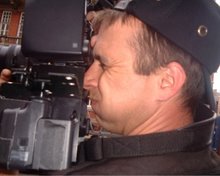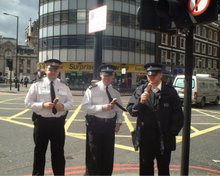


An estimated 600 police were on duty last Friday to police the Stop the War protest outside the QEII conference centre where Blair was giving evidence to the Iraq war inquiry. They probably outnumbered the protesters.
The demonstration had been stopped from assembling on the green of the QEII centre as they'd planned, and was instead coralled, without resistance, into Storey's gate and other side roads. There the policing relaxed, and as the day wore on, the ring of police and protesters around the conference centre began to resemble a giant square dance, unlikely to erupt into anything more threatening than an impromptu do-si-do.
The FIT, on the other hand, were keen to keep up their usual brand of intimidation and harassment. Photographer Neal Williams (pictured), along with his FIT minder, hovered behind the lines of TSG, every few minutes firing his camera flashgun in the faces of those picked out as 'potential trouble-makers'.
And the Hammersmith and Fulham cop (FH70), pictured top left, entered enthusiastically into the spirit of things, ordering three stop and searches, and at least one arrest for breach of the peace. He was a little too keen, perhaps, to impress his friends in the public order unit.
Pictures: Sgt FH70; Public Order police from Scotland Yard's CO11, CO5090 and Chief Inspector; Neal Williams, FIT photographer.









